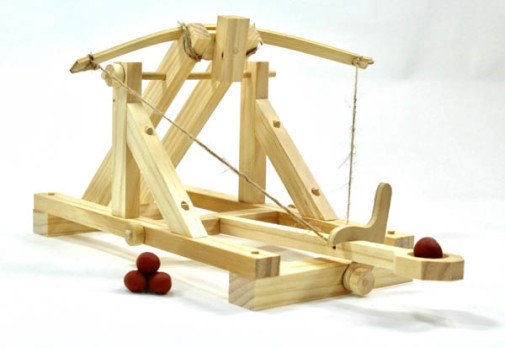We use cookies to make your experience better. To comply with the new e-Privacy directive, we need to ask for your consent to set the cookies. Learn more.
Roman Catapult (Ancient Siege Engines)
Catapults were awesome weapons originally invented in Greek and Roman Times. They can take many forms and we have made two kits, one using the power of torsion stored in twisted rope, and the other using the power of tension, stored in bamboo tensioners. Catapults also had slings attached to them, in which case they became onagers.
The main purpose of these all-natural, untreated wood kits is to demonstrate scientific principles in action. Heres how they work: each kit comes as a set of pre-cut wooden pieces, which are assembled according to illustrated black and white instructions. Once you finish putting everything together, the set becomes a fully-functional scientific or historical representation. The catapult, for example, stands at 8" tall, 5" wide, and can fling small objects over 15 feet. But its not just a glued-together wooden frame with a rubber band attached; these kits are put together almost precisely how the real thing was, using only authentic parts. Small wooden pegs (miniature versions of the huge pegs used in the real deal) connect crossbars, supports, and pieces of the frame just as nails would in modern-day building projects. A tiny rope strung through the middle and wound by torsion bars gives the catapult its power, allowing it to hurl miniature stand-ins such as fruit, marshmallows, or even tiny rocks in the exact same way several-hundred-pound projectiles were once thrown in medieval times.
The attention to detail and precise engineering of these kits is absolutely wonderful. While this level of complexity increases the time it takes to put together these kits (about 1 to 2 hours), it also drastically improves the functionality and realism. Kids can learn not only how modern and medieval inventions were put together, but they can also see the scientific principles in action that make them work. The creator of these kits even suggests combining the medieval siege weapons with math and physics lessons to learn about trajectories and graphing. The hydraulics-powered Robotic Arm is a great example of a scientific principle in action. Using three different syringes on a control panel of sorts, the arm can be used to move up and down, turn, and grab objects between two foam panels.
All kits are fully interactive. Catapults and trebuchets throw things, bridges can turn and lift using cranks and other wooden controls, and hydraulic machines can be controlled by liquid-filled syringes. These kits are also made to be supplemented with other toys; kids can use LEGO figures or other toys to man siege engines or operate bridge controls as a miniature train or other vehicle starts to cross. For more advanced builders and artists, all kits can be painted piece-by-piece to look even better.
| Product Format: | Other |
|---|---|
| Grades: | 4-AD |
| Brand: | Pathfinders Design + Technology |
| EAN/UPC: | 615872472888 |
| Length in Inches: | 7.5 |
| Width in Inches: | 12 |
| Height in Inches: | 2.25 |
| Weight in Pounds: | 1.05 |


What boy wouldn't like this as they learn history and make it come to life with their own hands.
To supplement ancient history unit
Christmas gift for grandson
To work on with my 11 year old grandson